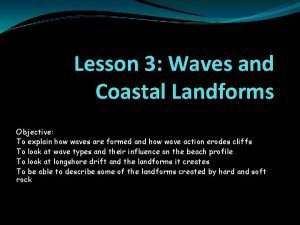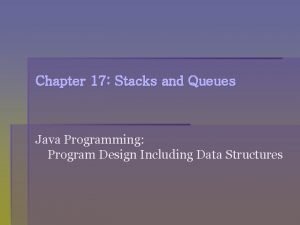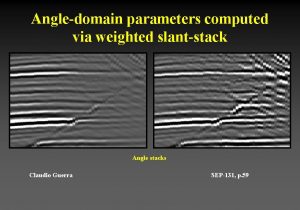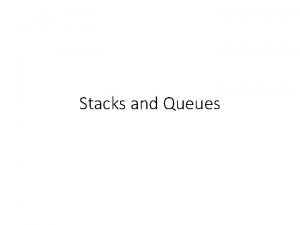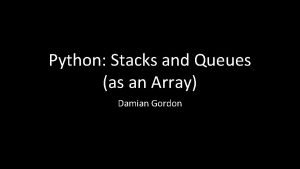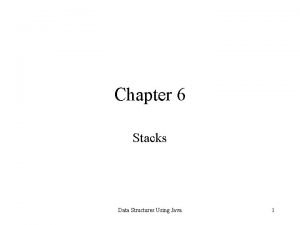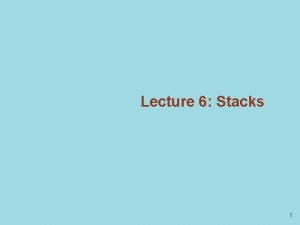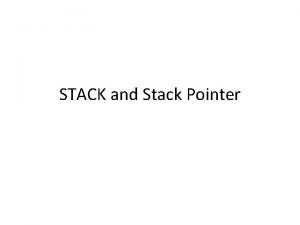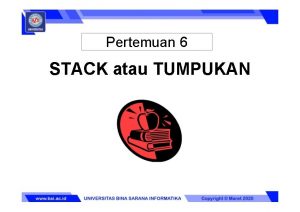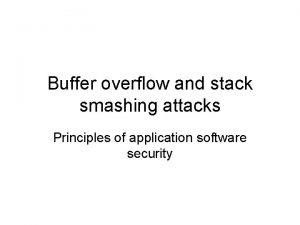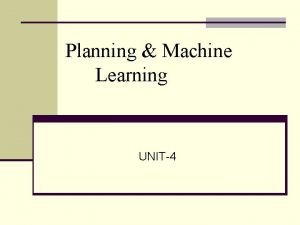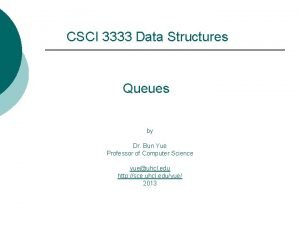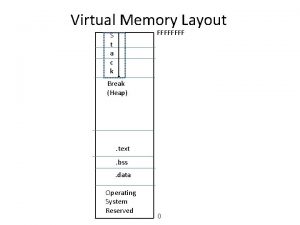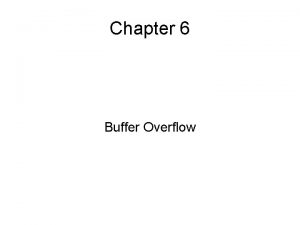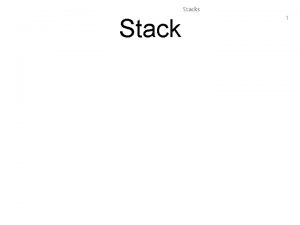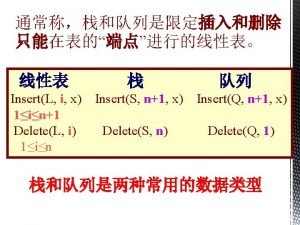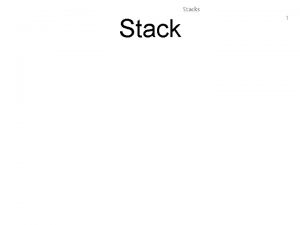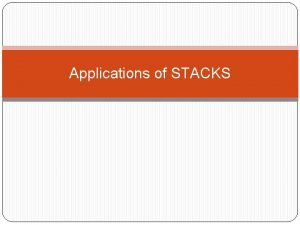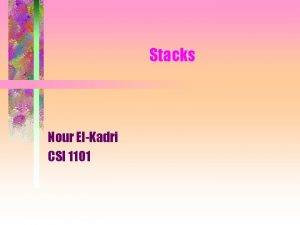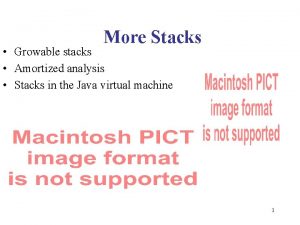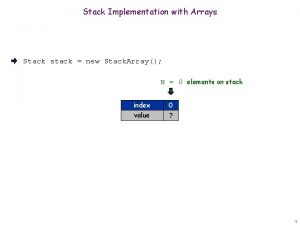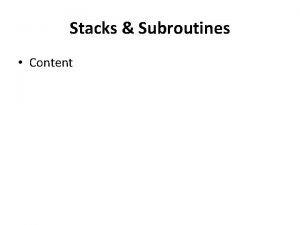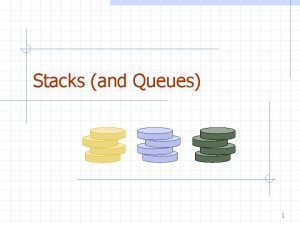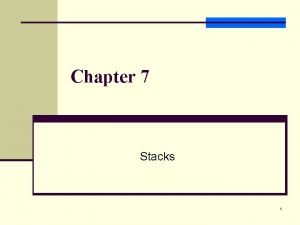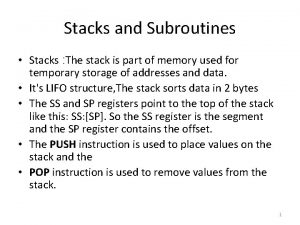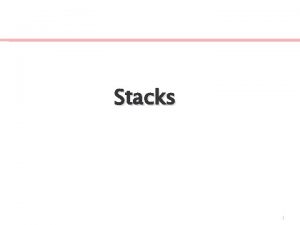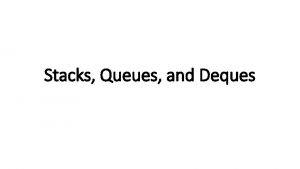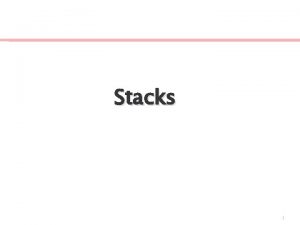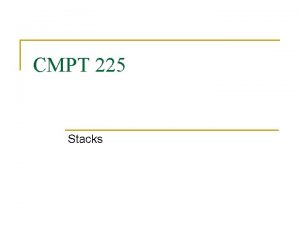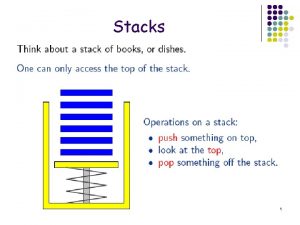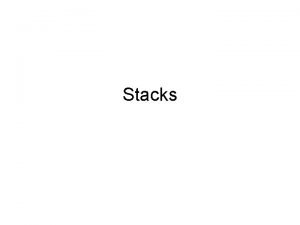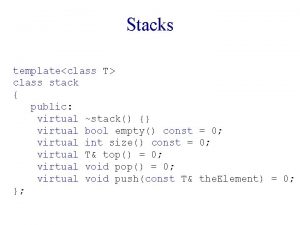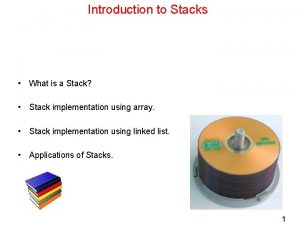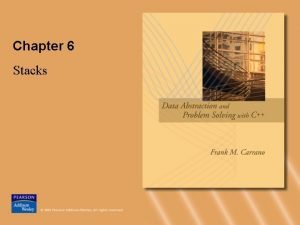Stacks What is a stack A stack is







}[()])) is balanced; ([]({()}[())]) is not • Simple counting is A balancing act • ([]({()}[()])) is balanced; ([]({()}[())]) is not • Simple counting is](https://slidetodoc.com/presentation_image_h/7665acfd1bd01766d277bade8de9744d/image-8.jpg)




















- Slides: 28

Stacks

What is a stack? • A stack is a Last In, First Out (LIFO) data structure • Anything added to the stack goes on the “top” of the stack • Anything removed from the stack is taken from the “top” of the stack • Things are removed in the reverse order from that in which they were inserted 2

Constructing a stack • To use stacks, you need import java. util. *; • There is just one stack constructor: Stack stack = new Stack(); 3

Stack operations I stack. push(object) – Adds the object to the top of the stack; the item pushed is also returned as the value of push object = stack. pop(); – Removes the object at the top of the stack and returns it object = stack. peek(); – Returns the top object of the stack but does not remove it from the stack 4

Stack operations II stack. empty() – Returns true if there is nothing in the stack int i = stack. search(object); – Returns the 1 -based position of the element on the stack. That is, the top element is at position 1, the next element is at position 2, and so on. – Returns -1 if the element is not on the stack 5

Stack ancestry • The Stack class extends the Vector class – Hence, anything you can do with a Vector, you can also do with a Stack – However, this is not how stacks are intended to be used – A “stack” is a very specific data structure, defined by the preceding operations; it just happens to be implemented by extending Vector – Use only the stack operations for Stacks! • The Vector class implements the Collection interface – Hence, anything you can do with a Collection, you can also do with a Stack – The most useful operation this gives you is to. Array() 6

Some uses of stacks • Stacks are used for: – Any sort of nesting (such as parentheses) – Evaluating arithmetic expressions (and other sorts of expression) – Implementing function or method calls – Keeping track of previous choices (as in backtracking) – Keeping track of choices yet to be made (as in creating a maze) 7
}[()])) is balanced; ([]({()}[())]) is not • Simple counting is](https://slidetodoc.com/presentation_image_h/7665acfd1bd01766d277bade8de9744d/image-8.jpg)
A balancing act • ([]({()}[()])) is balanced; ([]({()}[())]) is not • Simple counting is not enough to check balance • You can do it with a stack: going left to right, – If you see a (, [, or {, push it on the stack – If you see a ), ], or }, pop the stack and check whether you got the corresponding (, [, or { – When you reach the end, check that the stack is empty 8

Expression evaluation • Almost all higher-level languages let you evaluate expressions, such as 3*x+y or m=m+1 • The simplest case of an expression is one number (such as 3) or one variable name (such as x) – These are expressions • In many languages, = is considered to be an operator – Its value is (typically) the value of the left-hand side, after the assignment has occurred • Situations sometimes arise where you want to evaluate expressions yourself, without benefit of a compiler 9

Performing calculations • To evaluate an expression, such as 1+2*3+4, you need two stacks: one for operands (numbers), the other for operators: going left to right, – If you see a number, push it on the number stack – If you see an operator, • While the top of the operator stack holds an operator of equal or higher precedence: – pop the old operator – pop the top two values from the number stack and apply the old operator to them – push the result on the number stack • push the new operator on the operator stack – At the end, perform any remaining operations 10

Example: 1+2*3+4 • • • 1 : push 1 on number stack + : push + on op stack 2 : push 2 on number stack * : because * has higher precedence than +, push * onto op stack 3 : push 3 onto number stack + : because + has lower precedence than *: – pop 3, 2, and * – compute 2*3=6, and push 6 onto number stack – push + onto op stack • 4 : push 4 onto number stack • end : pop 4, 6 and +, compute 6+4=10, push 10; pop 10, 1, and +, compute 1+10=11, push 11 • 11 (at the top of the stack) is the answer 11

Handling parentheses • When you see a left parenthesis, (, treat it as a low -priority operator, and just put it on the operator stack • When you see a right parenthesis , ), perform all the operations on the operator stack until you reach the corresponding left parenthesis; then remove the left parenthesis 12

Handling variables • There are two ways to handle variables in an expression: – When you encounter the variable, look up its value, and put its value on the operand (number) stack • This simplifies working with the stack, since everything on it is a number – When you encounter a variable, put the variable itself on the stack; only look up its value later, when you need it • This allows you to have embedded assignments, such as 12 + (x = 5) * x 13

Handling the = operator • The assignment operator is just another operator – It has a lower precedence than the arithmetic operators – It should have a higher precedence than ( • To evaluate the = operator: – Evaluate the right-hand side (this will already have been done, if = has a low precedence) – Store the value of the right-hand side into the variable on the left-hand side • You can only do this if your stack contains variables as well as numbers – Push the value onto the stack 14

At the end • Two things result in multiple special cases – You frequently need to compare the priority of the current operator with the priority of the operator at the top of the stack—but the stack may be empty – Earlier, I said: “At the end, perform any remaining operations” • There is a simple way to avoid these special cases – Invent a new “operator, ” say, $, and push it on the stack initially – Give this operator the lowest possible priority – To “apply” this operator, just quit—you’re done 15

Some things that can go wrong • The expression may be ill-formed: 2+3+ • When you go to evaluate the second +, there won’t be two numbers on the stack 12+3 • When you are done evaluating the expression, you have more than one number on the stack (2 + 3 • You have an unmatched ( on the stack 2 + 3) • You can’t find a matching ( on the stack • The expression may use a variable that has not been assigned a value 16

Types of storage • In almost all languages (including Java), data is stored in two different ways: – Temporary variables—parameters and local variables of a method—are stored in a stack • These values are popped off the stack when the method returns • The value returned from a method is also temporary, and is put on the stack when the method returns, and removed again by the calling program – More permanent variables—objects and their instance variables and class variables—are kept in a heap • They remain on the heap until they are “freed” by the programmer (C, C++) or garbage collected (Java) 17

Stacks in Java • Stacks are used for local variables (including parameters) void method. A() { int x, y; // puts x, y on stack y = 0; method. B(); y++; } void method. B() { int y, z; // puts y, z on stack y = 5; return; // removes y, z } z y y x 18

Supporting recursion static int factorial(int n) { if (n <= 1) return 1; else return n * factorial(n - 1); } • If you call x = factorial(3), this enters the factorial method with n=3 on the stack • | factorial calls itself, putting n=2 on the stack • | | factorial calls itself, putting n=1 on the stack • | | factorial returns 1 • | factorial has n=2, computes and returns 2*1 = 2 • factorial has n=3, computes and returns 3*2 = 6 19

Factorial (animation 1) • x = factorial(3) 3 is put on stack as n • static int factorial(int n) { //n=3 int r = 1; r is put on stack with value 1 if (n <= 1) return r; else { r = n * factorial(n - 1); return r; r=1 All references to r use this r } All references to n use this n n=3 } Now we recur with 2. . . 20

Factorial (animation 2) • r = n * factorial(n - 1); 2 is put on stack as n • static int factorial(int n) {//n=2 int r = 1; r is put on stack with value 1 if (n <= 1) return r; Now using this r else { r = n * factorial(n - 1); And this n return r; } } Now we recur with 1. . . r=1 n=2 r=1 n=3 21

Factorial (animation 3) • r = n * factorial(n - 1); 1 is put on stack as n • Now using this r static int factorial(int n) { And r is put on stack with value 1 int r = 1; this n if (n <= 1) return r; else { r = n * factorial(n - 1); return r; Now we pop r and n } } off the stack and return 1 as factorial(1) r=1 n=1 r=1 n=2 r=1 n=3 22

Factorial (animation 4) • r = n * factorial(n - 1); Now using this r And this n r=1 • static int factorial(int n) { fac=1 n=1 int r = 1; if (n <= 1) return r; r=1 else { n=2 r = n * factorial(n - 1); return r; r=1 Now we pop r and n } off the stack and return n=3 } 1 as factorial(1) 23

Factorial (animation 5) • r = n * factorial(n - 1); • static int factorial(int n) { int r = 1; if (n <= 1) return r; Now using this r else { And r = n * factorial(n - 1); this n return r; 1 } 2 * 1 is 2; } Pop r and n; Return 2 r=1 fac=2 n=2 r=1 n=3 24

Factorial (animation 6) • x = factorial(3) • static int factorial(int n) { int r = 1; if (n <= 1) return r; else { r = n * factorial(n - 1); return r; Now using this r r=1 2 } 3 * 2 is 6; And n=3 fac=6 } this n Pop r and n; Return 6 25

Stack frames • Rather than pop variables off the stack one at a time, they are usually organized into stack frames • Each frame provides a set of variables and their values • This allows variables to be popped off all at once • There are several different ways stack frames can be implemented r=1 n=1 r=1 n=2 r=1 n=3 26

Summary • Stacks are useful for working with any nested structure, such as: – Arithmetic expressions – Nested statements in a programming language – Any sort of nested data 27

The End 28
 Longshore drift
Longshore drift Java stack exercises
Java stack exercises Speedstacks com go
Speedstacks com go Java stacks and queues
Java stacks and queues Angle stacks
Angle stacks What are stacks
What are stacks Two stack pushdown automata
Two stack pushdown automata Plant cells
Plant cells Types of stacks
Types of stacks Stacks+routined
Stacks+routined Stacks and queues in python
Stacks and queues in python Stacks internet
Stacks internet Stacks in data structures
Stacks in data structures 6 stacks
6 stacks Barrier bars geography
Barrier bars geography Characteristics of stack
Characteristics of stack Diketahui suatu stack dengan max_stack = 6
Diketahui suatu stack dengan max_stack = 6 Stack smashing
Stack smashing Els stack
Els stack Goal stack planning with example
Goal stack planning with example Grc stack
Grc stack Palindrome c++
Palindrome c++ Static data structure and dynamic data structure
Static data structure and dynamic data structure Virtual memory layout
Virtual memory layout Dale carnegie conversation stack
Dale carnegie conversation stack Virtualization stack
Virtualization stack Cup stacking cycle
Cup stacking cycle Stack overflow chapter 6
Stack overflow chapter 6 Polish notations
Polish notations
